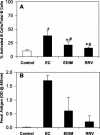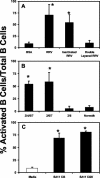The VP7 outer capsid protein of rotavirus induces polyclonal B-cell activation
- PMID: 15194774
- PMCID: PMC421650
- DOI: 10.1128/JVI.78.13.6974-6981.2004
The VP7 outer capsid protein of rotavirus induces polyclonal B-cell activation
Abstract
The early response to a homologous rotavirus infection in mice includes a T-cell-independent increase in the number of activated B lymphocytes in the Peyer's patches. The mechanism of this activation has not been previously determined. Since rotavirus has a repetitively arranged triple-layered capsid and repetitively arranged antigens can induce activation of B cells, one or more of the capsid proteins could be responsible for the initial activation of B cells during infection. To address this question, we assessed the ability of rotavirus and virus-like particles to induce B-cell activation in vivo and in vitro. Using infectious rotavirus, inactivated rotavirus, noninfectious but replication-competent virus, and virus-like particles, we determined that neither infectivity nor RNA was necessary for B-cell activation but the presence of the rotavirus outer capsid protein, VP7, was sufficient for murine B-cell activation. Preincubation of the virus with neutralizing VP7 antibodies inhibited B-cell activation. Polymyxin B treatment and boiling of the virus preparation were performed, which ruled out possible lipopolysaccharide contamination as the source of activation and confirmed that the structural conformation of VP7 is important for B-cell activation. These findings indicate that the structure and conformation of the outer capsid protein, VP7, initiate intestinal B-cell activation during rotavirus infection.
Figures



Similar articles
-
Antibodies to rotavirus outer capsid glycoprotein VP7 neutralize infectivity by inhibiting virion decapsidation.J Virol. 2002 Jul;76(13):6643-51. doi: 10.1128/jvi.76.13.6643-6651.2002. J Virol. 2002. PMID: 12050377 Free PMC article.
-
Inhibition of rotavirus replication by a non-neutralizing, rotavirus VP6-specific IgA mAb.J Clin Invest. 2002 May;109(9):1203-13. doi: 10.1172/JCI14397. J Clin Invest. 2002. PMID: 11994409 Free PMC article.
-
Recombinant Lactobacillus plantarum NC8 strain expressing porcine rotavirus VP7 induces specific antibodies in BALB/c mice.Acta Biochim Biophys Sin (Shanghai). 2021 May 21;53(6):707-718. doi: 10.1093/abbs/gmab050. Acta Biochim Biophys Sin (Shanghai). 2021. PMID: 33963824
-
Dendritic cell expression of MyD88 is required for rotavirus-induced B cell activation.J Virol. 2025 May 20;99(5):e0065325. doi: 10.1128/jvi.00653-25. Epub 2025 Apr 30. J Virol. 2025. PMID: 40304491 Free PMC article.
-
Distribution and phenotype of murine rotavirus-specific B cells induced by intranasal immunization with 2/6 virus-like particles.Eur J Immunol. 2005 Jul;35(7):2122-30. doi: 10.1002/eji.200526059. Eur J Immunol. 2005. PMID: 15948217
Cited by
-
Innate immune responses to human rotavirus in the neonatal gnotobiotic piglet disease model.Immunology. 2010 Oct;131(2):242-56. doi: 10.1111/j.1365-2567.2010.03298.x. Immunology. 2010. PMID: 20497255 Free PMC article.
-
Lack of evidence of rotavirus-dependent molecular mimicry as a trigger of coeliac disease.Clin Exp Immunol. 2016 Dec;186(3):356-363. doi: 10.1111/cei.12855. Epub 2016 Sep 29. Clin Exp Immunol. 2016. PMID: 27548641 Free PMC article.
-
Division of labor during primary humoral immunity.Immunol Res. 2013 Mar;55(1-3):277-86. doi: 10.1007/s12026-012-8372-9. Immunol Res. 2013. PMID: 22945808 Free PMC article. Review.
-
Type I IFN enhances follicular B cell contribution to the T cell-independent antibody response.J Exp Med. 2010 Jul 5;207(7):1485-500. doi: 10.1084/jem.20092695. Epub 2010 Jun 21. J Exp Med. 2010. PMID: 20566717 Free PMC article.
-
Plasmacytoid dendritic cells promote rotavirus-induced human and murine B cell responses.J Clin Invest. 2013 Jun;123(6):2464-74. doi: 10.1172/JCI60945. Epub 2013 May 1. J Clin Invest. 2013. PMID: 23635775 Free PMC article.
References
-
- Almeida, G. D., C. D. Porada, S. St. Jeor, and J. L. Ascensao. 1994. Human cytomegalovirus alters interleukin-6 production by endothelial cells. Blood 83:370-376. - PubMed
-
- Anders, E. M., A. A. Scalzo, and D. O. White. 1985. Mitogenic activity of influenza virus and haemagglutinin. Vaccine 3:241-244. - PubMed
-
- Bachmann, M. F., H. Hengartner, and R. M. Zinkernagel. 1995. T helper cell-independent neutralizing B cell response against vesicular stomatitis virus: role of antigen patterns in B cell induction? Eur. J. Immunol. 25:3445-3451. - PubMed
Publication types
MeSH terms
Substances
Grants and funding
LinkOut - more resources
Full Text Sources
Other Literature Sources

